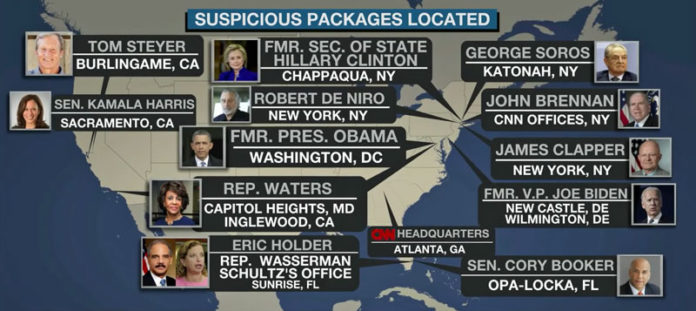
By Jorge L. Ortiz, USA TODAY
The series of bomb-like devices mailed in recent days to prominent Democratic figures and to CNN have not only increased concerns for elected officials but raised questions about how regular citizens would handle suspicious packages sent to them.
Unlike high-profile politicians, most people don’t have trained personnel or company mail rooms screening their correspondence for signs of trouble before getting them to their intended recipients.
(Another suspicious package was discovered Monday, this time addressed to CNN. It would be at least the 15th potentially explosive device Cesar Sayoc is accused of mailing to critics of the president. Courtesy of CBS Evening News and YouTube. Posted on Oct 29, 2018.)
Even with the increase in internet commerce and package delivery, mail-based threats are rare.
The U.S. Postal Service said in its annual report that it handled 150 billion pieces of mail last year and its inspectors responded to 2,282 incidents that involved suspicious items, substances, powders or liquids.
On a yearly basis, about 20 incidents result in criminal investigations.
When questionable items do get through, there are several common-sense measures the public can take in dealing with them, according to guidelines provided by the Department of Homeland Security and the USPS.
The DHS website lists anomalies that should raise red flags about a package, among them the following characteristics:
- Rigid or bulky
- Lopsided or uneven
- Wrapped in string
- Badly written or misspelled labels
- Generic or incorrect titles
- Excessive postage
- No postage
- Foreign writing, postage, or return address
- Missing, nonsensical, or unknown return address
- Leaks, stains, powders, or protruding materials
- Ticking, vibration or other sound

The USPS website offers a more graphic illustration, with a poster indicating some of those same traits, along with instructions for mail room employees.
James McClain, a vice president at the Pinkerton security and risk-management firm, said those are valuable tips, and he provides some others for people at home.
First and foremost, McClain said it’s important for recipients to be situationally aware. Were they expecting a package? Was it sent by someone they know?
If the answer to those questions is no, they should be at least mildly wary.
If they have any doubts, recipients should avoid handling packages – which could be set to detonate remotely or by a timer, not necessarily upon opening – and call 911 for further instructions.
“What we’ve seen in movies where you rush to remove it or put it into a safe spot, that’s not the way to proceed,’’ McClain said. “It’s best to leave it where you found it and, if you have handled it, put it down and go to a safe spot and contact local authorities.’’
Police will probably ask the caller a series of questions to assess the likelihood the parcel is dangerous, he said.
McClain said the most common mistake he notices is a failure to speak up when something’s amiss.
“We’ve all seen something that has caught our eye — whether it’s in public transportation, in or around a work site or our day-to-day activity, but we quickly think, ‘Well, it’s probably nothing,’ or, ‘Someone else will report it,’’’ he said.
“I believe the ‘see something, say something’ philosophy is the best approach.’’
Original Post https://www.usatoday.com/story/news/2018/10/25/suspicious-package-how-identify-and-what-do/1767259002/
FBI’s Investigation of Suspicious Packages
 By the FBI
By the FBI
Between October 22 and 24, 2018, suspicious packages were received at multiple locations in the New York and Washington, D.C., areas and Florida.
The packages are being sent for analysis at the FBI Laboratory in Quantico, Virginia.
“This investigation is of the highest priority for the FBI. We have committed the full strength of the FBI’s resources and, together with our partners on our Joint Terrorism Task Forces, we will continue to work to identify and arrest whoever is responsible for sending these packages,” said FBI Director Christopher Wray.
“We ask anyone who may have information to contact the FBI. Do not hesitate to call; no piece of information is too small to help us in this investigation.”
The packages are similar in appearance, as depicted in the below photograph, and contain potentially destructive devices.
The packages were mailed in manila envelopes with bubble wrap interior.
The packages were affixed with computer-printed address labels and six Forever stamps.
All packages had a return address of “DEBBIE WASSERMAN SHULTZ” [sic] in Florida. Packages identified to date were addressed to:
-
George Soros
-
Former Secretary of State Hillary Clinton
-
Former President Barack Obama
-
Former CIA Director John Brennan, care of CNN
-
Former Attorney General Eric Holder

















